Organizational Behavior: Tesco's Culture, Politics, and Motivation
VerifiedAdded on 2020/06/06
|13
|5831
|48
Report
AI Summary
This report delves into the realm of organizational behavior, utilizing Tesco as a case study to analyze how company culture, politics, and power dynamics influence individual and team behavior. It explores the impact of these factors, referencing models like Charles Handy's social model to understand Tesco's organizational structure. The report examines the role of individual behavior, role definitions, and political influences within the organization. Furthermore, it investigates the effects of cultural diversity on team performance. The study also provides an overview of motivation theories, including content and process theories, as well as Maslow's hierarchy of needs, to understand how to enhance employee motivation. The report concludes by discussing qualities of effective teams and theories of team and group development, offering a comprehensive analysis of organizational behavior principles within a real-world business context.
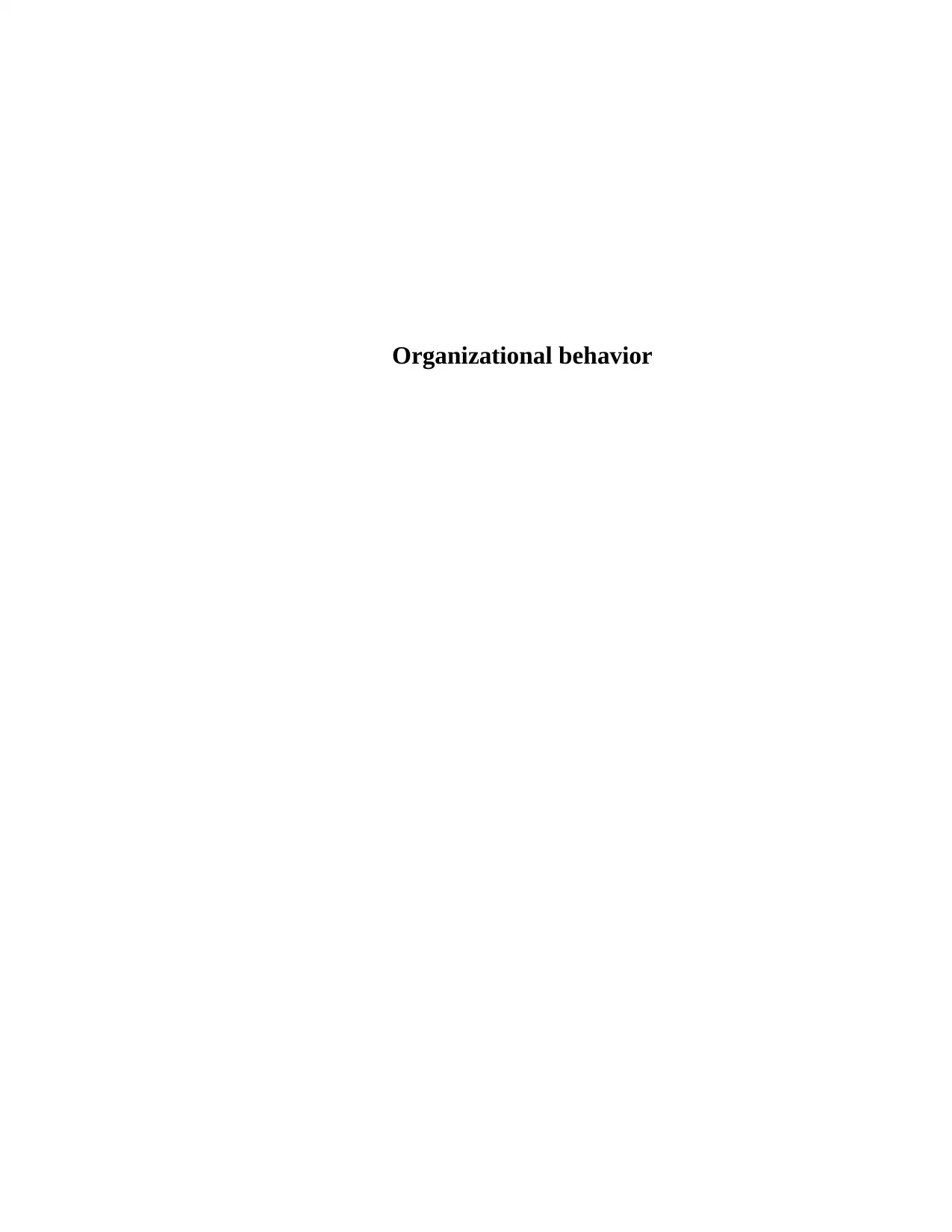
Organizational behavior
Paraphrase This Document
Need a fresh take? Get an instant paraphrase of this document with our AI Paraphraser
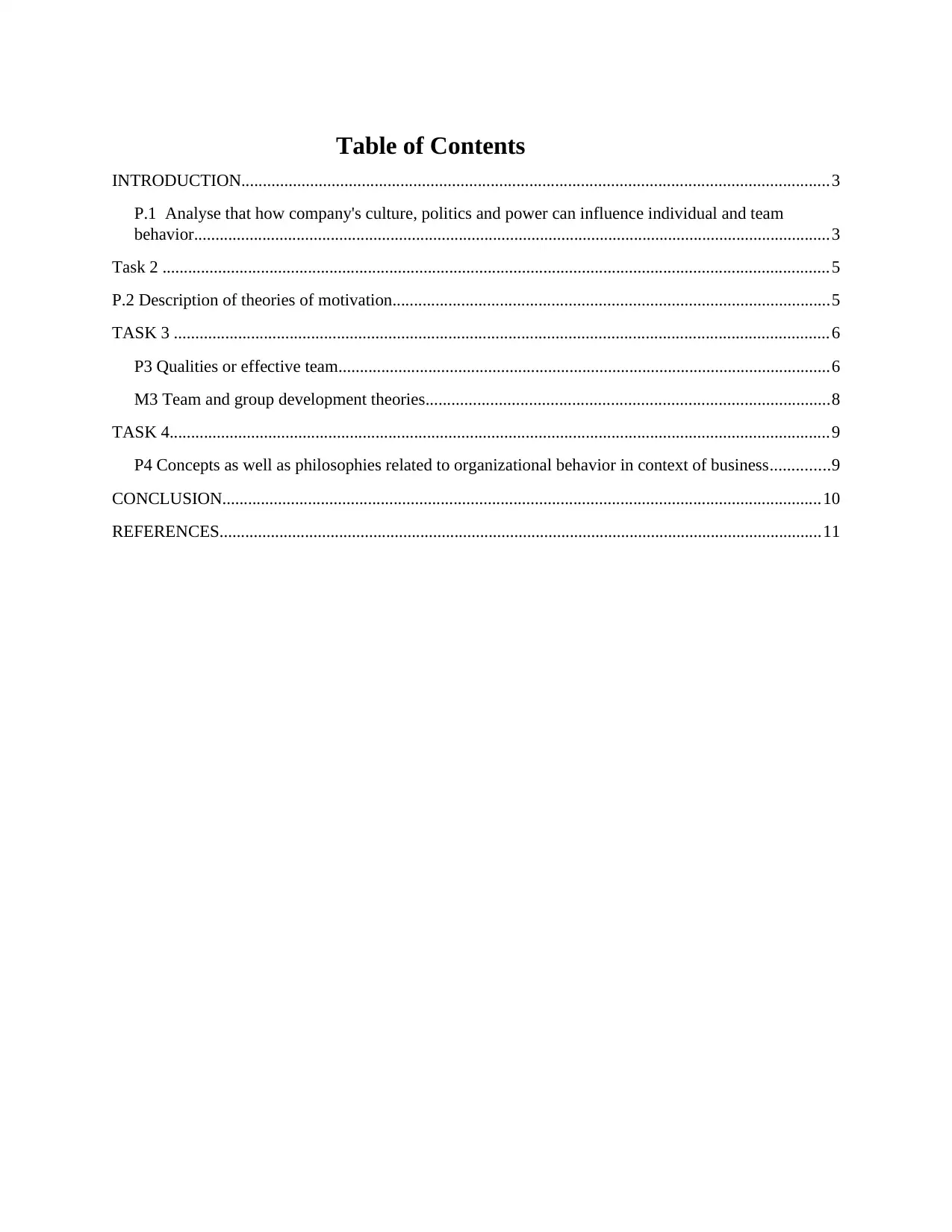
Table of Contents
INTRODUCTION.........................................................................................................................................3
P.1 Analyse that how company's culture, politics and power can influence individual and team
behavior.....................................................................................................................................................3
Task 2 ............................................................................................................................................................5
P.2 Description of theories of motivation......................................................................................................5
TASK 3 .........................................................................................................................................................6
P3 Qualities or effective team...................................................................................................................6
M3 Team and group development theories..............................................................................................8
TASK 4..........................................................................................................................................................9
P4 Concepts as well as philosophies related to organizational behavior in context of business..............9
CONCLUSION............................................................................................................................................10
REFERENCES.............................................................................................................................................11
INTRODUCTION.........................................................................................................................................3
P.1 Analyse that how company's culture, politics and power can influence individual and team
behavior.....................................................................................................................................................3
Task 2 ............................................................................................................................................................5
P.2 Description of theories of motivation......................................................................................................5
TASK 3 .........................................................................................................................................................6
P3 Qualities or effective team...................................................................................................................6
M3 Team and group development theories..............................................................................................8
TASK 4..........................................................................................................................................................9
P4 Concepts as well as philosophies related to organizational behavior in context of business..............9
CONCLUSION............................................................................................................................................10
REFERENCES.............................................................................................................................................11
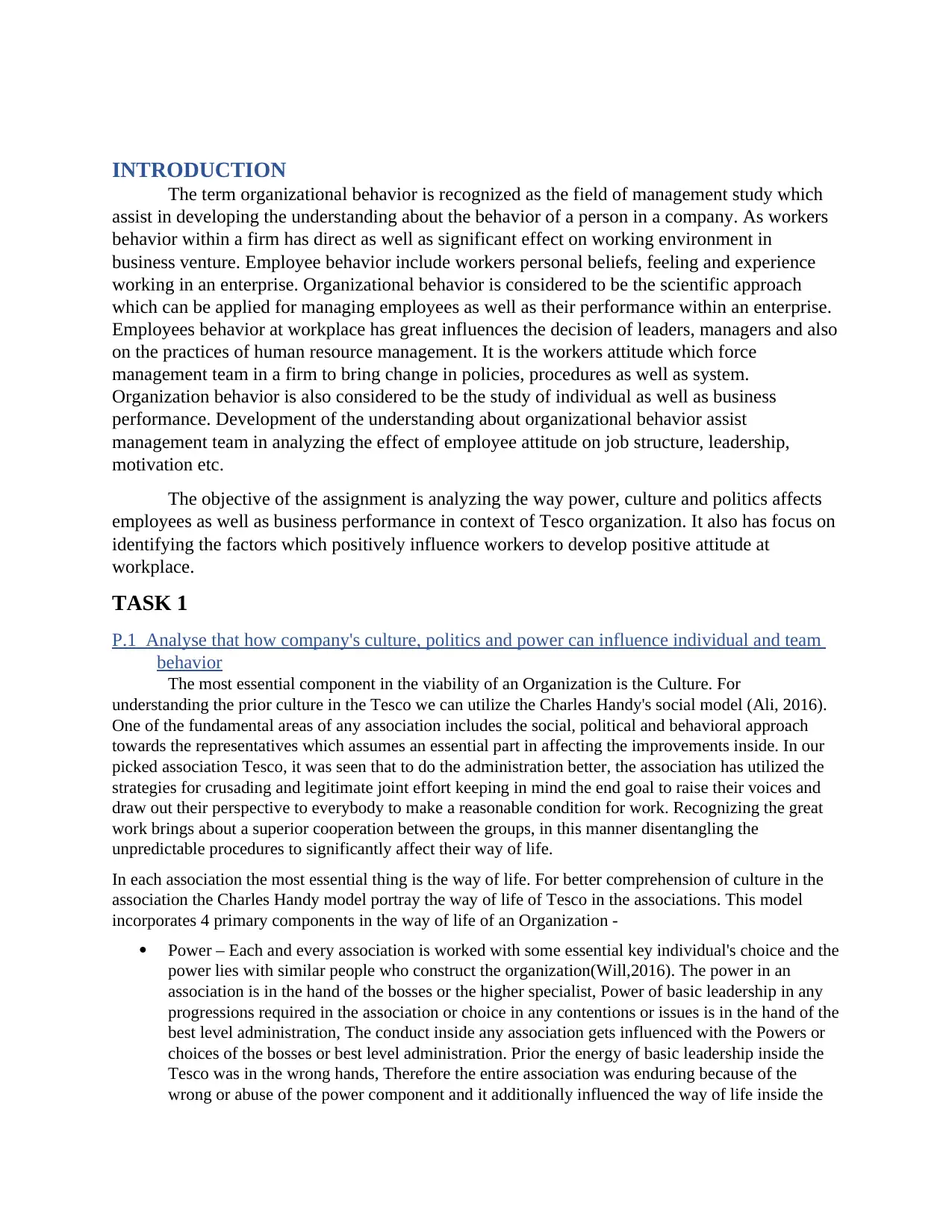
INTRODUCTION
The term organizational behavior is recognized as the field of management study which
assist in developing the understanding about the behavior of a person in a company. As workers
behavior within a firm has direct as well as significant effect on working environment in
business venture. Employee behavior include workers personal beliefs, feeling and experience
working in an enterprise. Organizational behavior is considered to be the scientific approach
which can be applied for managing employees as well as their performance within an enterprise.
Employees behavior at workplace has great influences the decision of leaders, managers and also
on the practices of human resource management. It is the workers attitude which force
management team in a firm to bring change in policies, procedures as well as system.
Organization behavior is also considered to be the study of individual as well as business
performance. Development of the understanding about organizational behavior assist
management team in analyzing the effect of employee attitude on job structure, leadership,
motivation etc.
The objective of the assignment is analyzing the way power, culture and politics affects
employees as well as business performance in context of Tesco organization. It also has focus on
identifying the factors which positively influence workers to develop positive attitude at
workplace.
TASK 1
P.1 Analyse that how company's culture, politics and power can influence individual and team
behavior
The most essential component in the viability of an Organization is the Culture. For
understanding the prior culture in the Tesco we can utilize the Charles Handy's social model (Ali, 2016).
One of the fundamental areas of any association includes the social, political and behavioral approach
towards the representatives which assumes an essential part in affecting the improvements inside. In our
picked association Tesco, it was seen that to do the administration better, the association has utilized the
strategies for crusading and legitimate joint effort keeping in mind the end goal to raise their voices and
draw out their perspective to everybody to make a reasonable condition for work. Recognizing the great
work brings about a superior cooperation between the groups, in this manner disentangling the
unpredictable procedures to significantly affect their way of life.
In each association the most essential thing is the way of life. For better comprehension of culture in the
association the Charles Handy model portray the way of life of Tesco in the associations. This model
incorporates 4 primary components in the way of life of an Organization -
Power – Each and every association is worked with some essential key individual's choice and the
power lies with similar people who construct the organization(Will,2016). The power in an
association is in the hand of the bosses or the higher specialist, Power of basic leadership in any
progressions required in the association or choice in any contentions or issues is in the hand of the
best level administration, The conduct inside any association gets influenced with the Powers or
choices of the bosses or best level administration. Prior the energy of basic leadership inside the
Tesco was in the wrong hands, Therefore the entire association was enduring because of the
wrong or abuse of the power component and it additionally influenced the way of life inside the
The term organizational behavior is recognized as the field of management study which
assist in developing the understanding about the behavior of a person in a company. As workers
behavior within a firm has direct as well as significant effect on working environment in
business venture. Employee behavior include workers personal beliefs, feeling and experience
working in an enterprise. Organizational behavior is considered to be the scientific approach
which can be applied for managing employees as well as their performance within an enterprise.
Employees behavior at workplace has great influences the decision of leaders, managers and also
on the practices of human resource management. It is the workers attitude which force
management team in a firm to bring change in policies, procedures as well as system.
Organization behavior is also considered to be the study of individual as well as business
performance. Development of the understanding about organizational behavior assist
management team in analyzing the effect of employee attitude on job structure, leadership,
motivation etc.
The objective of the assignment is analyzing the way power, culture and politics affects
employees as well as business performance in context of Tesco organization. It also has focus on
identifying the factors which positively influence workers to develop positive attitude at
workplace.
TASK 1
P.1 Analyse that how company's culture, politics and power can influence individual and team
behavior
The most essential component in the viability of an Organization is the Culture. For
understanding the prior culture in the Tesco we can utilize the Charles Handy's social model (Ali, 2016).
One of the fundamental areas of any association includes the social, political and behavioral approach
towards the representatives which assumes an essential part in affecting the improvements inside. In our
picked association Tesco, it was seen that to do the administration better, the association has utilized the
strategies for crusading and legitimate joint effort keeping in mind the end goal to raise their voices and
draw out their perspective to everybody to make a reasonable condition for work. Recognizing the great
work brings about a superior cooperation between the groups, in this manner disentangling the
unpredictable procedures to significantly affect their way of life.
In each association the most essential thing is the way of life. For better comprehension of culture in the
association the Charles Handy model portray the way of life of Tesco in the associations. This model
incorporates 4 primary components in the way of life of an Organization -
Power – Each and every association is worked with some essential key individual's choice and the
power lies with similar people who construct the organization(Will,2016). The power in an
association is in the hand of the bosses or the higher specialist, Power of basic leadership in any
progressions required in the association or choice in any contentions or issues is in the hand of the
best level administration, The conduct inside any association gets influenced with the Powers or
choices of the bosses or best level administration. Prior the energy of basic leadership inside the
Tesco was in the wrong hands, Therefore the entire association was enduring because of the
wrong or abuse of the power component and it additionally influenced the way of life inside the
⊘ This is a preview!⊘
Do you want full access?
Subscribe today to unlock all pages.

Trusted by 1+ million students worldwide
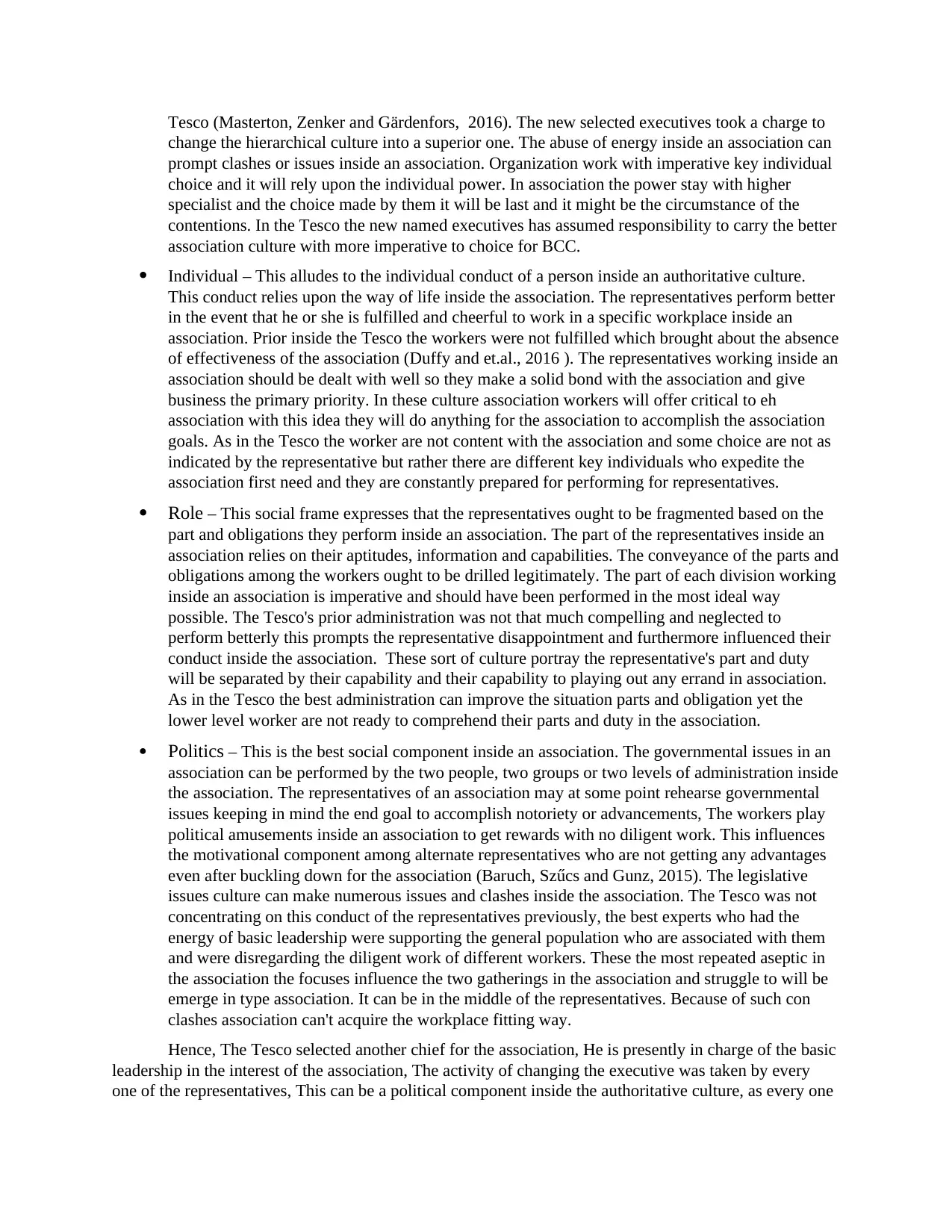
Tesco (Masterton, Zenker and Gärdenfors, 2016). The new selected executives took a charge to
change the hierarchical culture into a superior one. The abuse of energy inside an association can
prompt clashes or issues inside an association. Organization work with imperative key individual
choice and it will rely upon the individual power. In association the power stay with higher
specialist and the choice made by them it will be last and it might be the circumstance of the
contentions. In the Tesco the new named executives has assumed responsibility to carry the better
association culture with more imperative to choice for BCC.
Individual – This alludes to the individual conduct of a person inside an authoritative culture.
This conduct relies upon the way of life inside the association. The representatives perform better
in the event that he or she is fulfilled and cheerful to work in a specific workplace inside an
association. Prior inside the Tesco the workers were not fulfilled which brought about the absence
of effectiveness of the association (Duffy and et.al., 2016 ). The representatives working inside an
association should be dealt with well so they make a solid bond with the association and give
business the primary priority. In these culture association workers will offer critical to eh
association with this idea they will do anything for the association to accomplish the association
goals. As in the Tesco the worker are not content with the association and some choice are not as
indicated by the representative but rather there are different key individuals who expedite the
association first need and they are constantly prepared for performing for representatives.
Role – This social frame expresses that the representatives ought to be fragmented based on the
part and obligations they perform inside an association. The part of the representatives inside an
association relies on their aptitudes, information and capabilities. The conveyance of the parts and
obligations among the workers ought to be drilled legitimately. The part of each division working
inside an association is imperative and should have been performed in the most ideal way
possible. The Tesco's prior administration was not that much compelling and neglected to
perform betterly this prompts the representative disappointment and furthermore influenced their
conduct inside the association. These sort of culture portray the representative's part and duty
will be separated by their capability and their capability to playing out any errand in association.
As in the Tesco the best administration can improve the situation parts and obligation yet the
lower level worker are not ready to comprehend their parts and duty in the association.
Politics – This is the best social component inside an association. The governmental issues in an
association can be performed by the two people, two groups or two levels of administration inside
the association. The representatives of an association may at some point rehearse governmental
issues keeping in mind the end goal to accomplish notoriety or advancements, The workers play
political amusements inside an association to get rewards with no diligent work. This influences
the motivational component among alternate representatives who are not getting any advantages
even after buckling down for the association (Baruch, Szűcs and Gunz, 2015). The legislative
issues culture can make numerous issues and clashes inside the association. The Tesco was not
concentrating on this conduct of the representatives previously, the best experts who had the
energy of basic leadership were supporting the general population who are associated with them
and were disregarding the diligent work of different workers. These the most repeated aseptic in
the association the focuses influence the two gatherings in the association and struggle to will be
emerge in type association. It can be in the middle of the representatives. Because of such con
clashes association can't acquire the workplace fitting way.
Hence, The Tesco selected another chief for the association, He is presently in charge of the basic
leadership in the interest of the association, The activity of changing the executive was taken by every
one of the representatives, This can be a political component inside the authoritative culture, as every one
change the hierarchical culture into a superior one. The abuse of energy inside an association can
prompt clashes or issues inside an association. Organization work with imperative key individual
choice and it will rely upon the individual power. In association the power stay with higher
specialist and the choice made by them it will be last and it might be the circumstance of the
contentions. In the Tesco the new named executives has assumed responsibility to carry the better
association culture with more imperative to choice for BCC.
Individual – This alludes to the individual conduct of a person inside an authoritative culture.
This conduct relies upon the way of life inside the association. The representatives perform better
in the event that he or she is fulfilled and cheerful to work in a specific workplace inside an
association. Prior inside the Tesco the workers were not fulfilled which brought about the absence
of effectiveness of the association (Duffy and et.al., 2016 ). The representatives working inside an
association should be dealt with well so they make a solid bond with the association and give
business the primary priority. In these culture association workers will offer critical to eh
association with this idea they will do anything for the association to accomplish the association
goals. As in the Tesco the worker are not content with the association and some choice are not as
indicated by the representative but rather there are different key individuals who expedite the
association first need and they are constantly prepared for performing for representatives.
Role – This social frame expresses that the representatives ought to be fragmented based on the
part and obligations they perform inside an association. The part of the representatives inside an
association relies on their aptitudes, information and capabilities. The conveyance of the parts and
obligations among the workers ought to be drilled legitimately. The part of each division working
inside an association is imperative and should have been performed in the most ideal way
possible. The Tesco's prior administration was not that much compelling and neglected to
perform betterly this prompts the representative disappointment and furthermore influenced their
conduct inside the association. These sort of culture portray the representative's part and duty
will be separated by their capability and their capability to playing out any errand in association.
As in the Tesco the best administration can improve the situation parts and obligation yet the
lower level worker are not ready to comprehend their parts and duty in the association.
Politics – This is the best social component inside an association. The governmental issues in an
association can be performed by the two people, two groups or two levels of administration inside
the association. The representatives of an association may at some point rehearse governmental
issues keeping in mind the end goal to accomplish notoriety or advancements, The workers play
political amusements inside an association to get rewards with no diligent work. This influences
the motivational component among alternate representatives who are not getting any advantages
even after buckling down for the association (Baruch, Szűcs and Gunz, 2015). The legislative
issues culture can make numerous issues and clashes inside the association. The Tesco was not
concentrating on this conduct of the representatives previously, the best experts who had the
energy of basic leadership were supporting the general population who are associated with them
and were disregarding the diligent work of different workers. These the most repeated aseptic in
the association the focuses influence the two gatherings in the association and struggle to will be
emerge in type association. It can be in the middle of the representatives. Because of such con
clashes association can't acquire the workplace fitting way.
Hence, The Tesco selected another chief for the association, He is presently in charge of the basic
leadership in the interest of the association, The activity of changing the executive was taken by every
one of the representatives, This can be a political component inside the authoritative culture, as every one
Paraphrase This Document
Need a fresh take? Get an instant paraphrase of this document with our AI Paraphraser
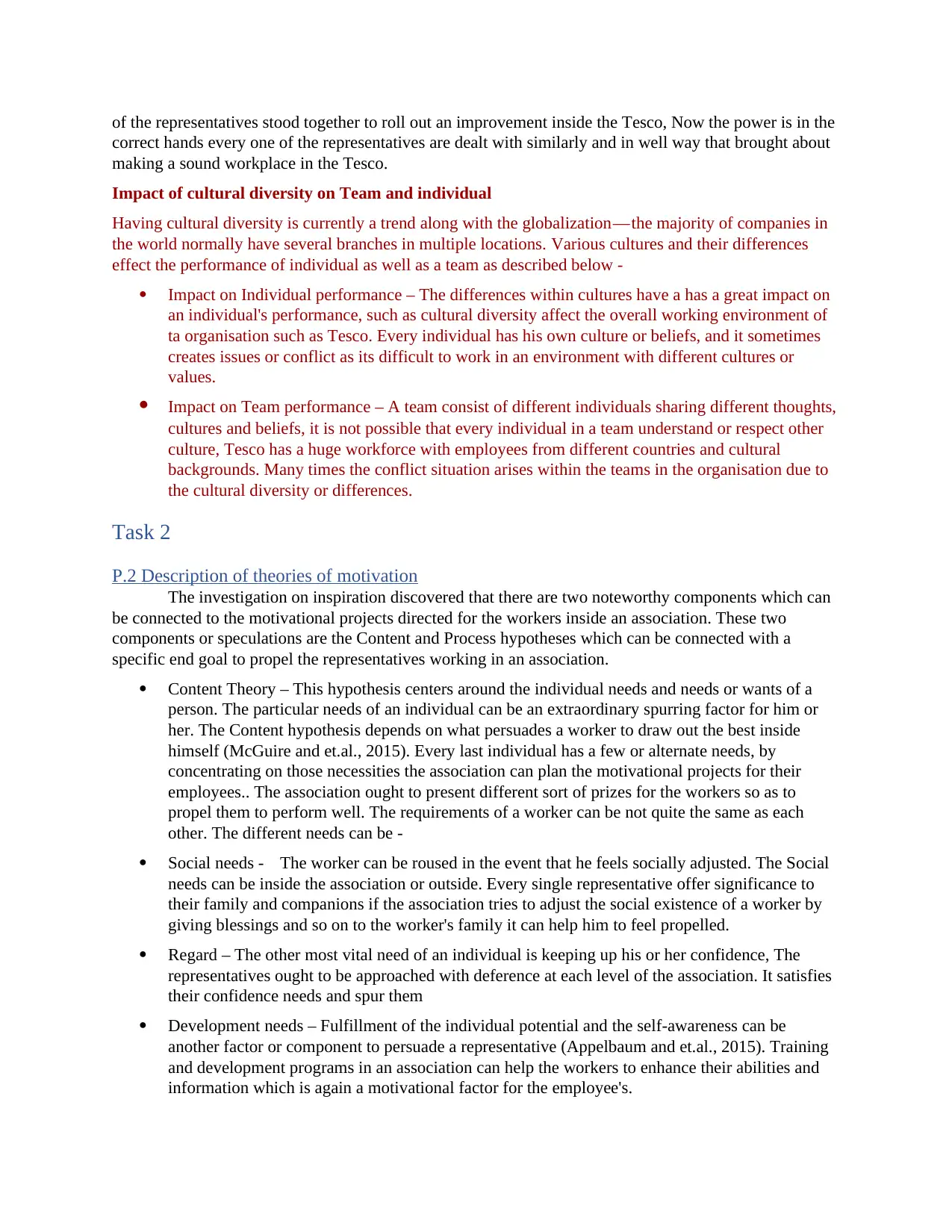
of the representatives stood together to roll out an improvement inside the Tesco, Now the power is in the
correct hands every one of the representatives are dealt with similarly and in well way that brought about
making a sound workplace in the Tesco.
Impact of cultural diversity on Team and individual
Having cultural diversity is currently a trend along with the globalization — the majority of companies in
the world normally have several branches in multiple locations. Various cultures and their differences
effect the performance of individual as well as a team as described below -
Impact on Individual performance – The differences within cultures have a has a great impact on
an individual's performance, such as cultural diversity affect the overall working environment of
ta organisation such as Tesco. Every individual has his own culture or beliefs, and it sometimes
creates issues or conflict as its difficult to work in an environment with different cultures or
values.
Impact on Team performance – A team consist of different individuals sharing different thoughts,
cultures and beliefs, it is not possible that every individual in a team understand or respect other
culture, Tesco has a huge workforce with employees from different countries and cultural
backgrounds. Many times the conflict situation arises within the teams in the organisation due to
the cultural diversity or differences.
Task 2
P.2 Description of theories of motivation
The investigation on inspiration discovered that there are two noteworthy components which can
be connected to the motivational projects directed for the workers inside an association. These two
components or speculations are the Content and Process hypotheses which can be connected with a
specific end goal to propel the representatives working in an association.
Content Theory – This hypothesis centers around the individual needs and needs or wants of a
person. The particular needs of an individual can be an extraordinary spurring factor for him or
her. The Content hypothesis depends on what persuades a worker to draw out the best inside
himself (McGuire and et.al., 2015). Every last individual has a few or alternate needs, by
concentrating on those necessities the association can plan the motivational projects for their
employees.. The association ought to present different sort of prizes for the workers so as to
propel them to perform well. The requirements of a worker can be not quite the same as each
other. The different needs can be -
Social needs - The worker can be roused in the event that he feels socially adjusted. The Social
needs can be inside the association or outside. Every single representative offer significance to
their family and companions if the association tries to adjust the social existence of a worker by
giving blessings and so on to the worker's family it can help him to feel propelled.
Regard – The other most vital need of an individual is keeping up his or her confidence, The
representatives ought to be approached with deference at each level of the association. It satisfies
their confidence needs and spur them
Development needs – Fulfillment of the individual potential and the self-awareness can be
another factor or component to persuade a representative (Appelbaum and et.al., 2015). Training
and development programs in an association can help the workers to enhance their abilities and
information which is again a motivational factor for the employee's.
correct hands every one of the representatives are dealt with similarly and in well way that brought about
making a sound workplace in the Tesco.
Impact of cultural diversity on Team and individual
Having cultural diversity is currently a trend along with the globalization — the majority of companies in
the world normally have several branches in multiple locations. Various cultures and their differences
effect the performance of individual as well as a team as described below -
Impact on Individual performance – The differences within cultures have a has a great impact on
an individual's performance, such as cultural diversity affect the overall working environment of
ta organisation such as Tesco. Every individual has his own culture or beliefs, and it sometimes
creates issues or conflict as its difficult to work in an environment with different cultures or
values.
Impact on Team performance – A team consist of different individuals sharing different thoughts,
cultures and beliefs, it is not possible that every individual in a team understand or respect other
culture, Tesco has a huge workforce with employees from different countries and cultural
backgrounds. Many times the conflict situation arises within the teams in the organisation due to
the cultural diversity or differences.
Task 2
P.2 Description of theories of motivation
The investigation on inspiration discovered that there are two noteworthy components which can
be connected to the motivational projects directed for the workers inside an association. These two
components or speculations are the Content and Process hypotheses which can be connected with a
specific end goal to propel the representatives working in an association.
Content Theory – This hypothesis centers around the individual needs and needs or wants of a
person. The particular needs of an individual can be an extraordinary spurring factor for him or
her. The Content hypothesis depends on what persuades a worker to draw out the best inside
himself (McGuire and et.al., 2015). Every last individual has a few or alternate needs, by
concentrating on those necessities the association can plan the motivational projects for their
employees.. The association ought to present different sort of prizes for the workers so as to
propel them to perform well. The requirements of a worker can be not quite the same as each
other. The different needs can be -
Social needs - The worker can be roused in the event that he feels socially adjusted. The Social
needs can be inside the association or outside. Every single representative offer significance to
their family and companions if the association tries to adjust the social existence of a worker by
giving blessings and so on to the worker's family it can help him to feel propelled.
Regard – The other most vital need of an individual is keeping up his or her confidence, The
representatives ought to be approached with deference at each level of the association. It satisfies
their confidence needs and spur them
Development needs – Fulfillment of the individual potential and the self-awareness can be
another factor or component to persuade a representative (Appelbaum and et.al., 2015). Training
and development programs in an association can help the workers to enhance their abilities and
information which is again a motivational factor for the employee's.
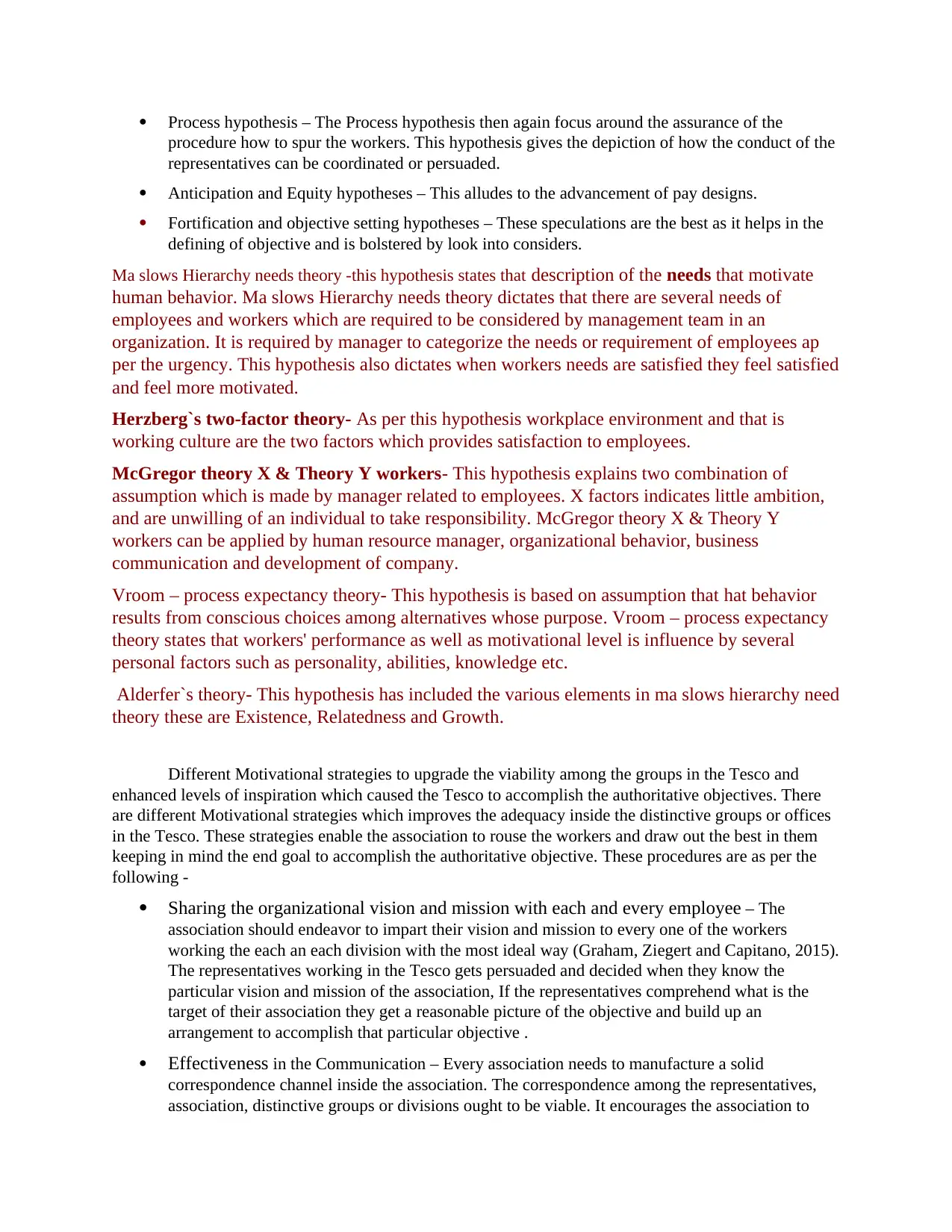
Process hypothesis – The Process hypothesis then again focus around the assurance of the
procedure how to spur the workers. This hypothesis gives the depiction of how the conduct of the
representatives can be coordinated or persuaded.
Anticipation and Equity hypotheses – This alludes to the advancement of pay designs.
Fortification and objective setting hypotheses – These speculations are the best as it helps in the
defining of objective and is bolstered by look into considers.
Ma slows Hierarchy needs theory -this hypothesis states that description of the needs that motivate
human behavior. Ma slows Hierarchy needs theory dictates that there are several needs of
employees and workers which are required to be considered by management team in an
organization. It is required by manager to categorize the needs or requirement of employees ap
per the urgency. This hypothesis also dictates when workers needs are satisfied they feel satisfied
and feel more motivated.
Herzberg`s two-factor theory- As per this hypothesis workplace environment and that is
working culture are the two factors which provides satisfaction to employees.
McGregor theory X & Theory Y workers- This hypothesis explains two combination of
assumption which is made by manager related to employees. X factors indicates little ambition,
and are unwilling of an individual to take responsibility. McGregor theory X & Theory Y
workers can be applied by human resource manager, organizational behavior, business
communication and development of company.
Vroom – process expectancy theory- This hypothesis is based on assumption that hat behavior
results from conscious choices among alternatives whose purpose. Vroom – process expectancy
theory states that workers' performance as well as motivational level is influence by several
personal factors such as personality, abilities, knowledge etc.
Alderfer`s theory- This hypothesis has included the various elements in ma slows hierarchy need
theory these are Existence, Relatedness and Growth.
Different Motivational strategies to upgrade the viability among the groups in the Tesco and
enhanced levels of inspiration which caused the Tesco to accomplish the authoritative objectives. There
are different Motivational strategies which improves the adequacy inside the distinctive groups or offices
in the Tesco. These strategies enable the association to rouse the workers and draw out the best in them
keeping in mind the end goal to accomplish the authoritative objective. These procedures are as per the
following -
Sharing the organizational vision and mission with each and every employee – The
association should endeavor to impart their vision and mission to every one of the workers
working the each an each division with the most ideal way (Graham, Ziegert and Capitano, 2015).
The representatives working in the Tesco gets persuaded and decided when they know the
particular vision and mission of the association, If the representatives comprehend what is the
target of their association they get a reasonable picture of the objective and build up an
arrangement to accomplish that particular objective .
Effectiveness in the Communication – Every association needs to manufacture a solid
correspondence channel inside the association. The correspondence among the representatives,
association, distinctive groups or divisions ought to be viable. It encourages the association to
procedure how to spur the workers. This hypothesis gives the depiction of how the conduct of the
representatives can be coordinated or persuaded.
Anticipation and Equity hypotheses – This alludes to the advancement of pay designs.
Fortification and objective setting hypotheses – These speculations are the best as it helps in the
defining of objective and is bolstered by look into considers.
Ma slows Hierarchy needs theory -this hypothesis states that description of the needs that motivate
human behavior. Ma slows Hierarchy needs theory dictates that there are several needs of
employees and workers which are required to be considered by management team in an
organization. It is required by manager to categorize the needs or requirement of employees ap
per the urgency. This hypothesis also dictates when workers needs are satisfied they feel satisfied
and feel more motivated.
Herzberg`s two-factor theory- As per this hypothesis workplace environment and that is
working culture are the two factors which provides satisfaction to employees.
McGregor theory X & Theory Y workers- This hypothesis explains two combination of
assumption which is made by manager related to employees. X factors indicates little ambition,
and are unwilling of an individual to take responsibility. McGregor theory X & Theory Y
workers can be applied by human resource manager, organizational behavior, business
communication and development of company.
Vroom – process expectancy theory- This hypothesis is based on assumption that hat behavior
results from conscious choices among alternatives whose purpose. Vroom – process expectancy
theory states that workers' performance as well as motivational level is influence by several
personal factors such as personality, abilities, knowledge etc.
Alderfer`s theory- This hypothesis has included the various elements in ma slows hierarchy need
theory these are Existence, Relatedness and Growth.
Different Motivational strategies to upgrade the viability among the groups in the Tesco and
enhanced levels of inspiration which caused the Tesco to accomplish the authoritative objectives. There
are different Motivational strategies which improves the adequacy inside the distinctive groups or offices
in the Tesco. These strategies enable the association to rouse the workers and draw out the best in them
keeping in mind the end goal to accomplish the authoritative objective. These procedures are as per the
following -
Sharing the organizational vision and mission with each and every employee – The
association should endeavor to impart their vision and mission to every one of the workers
working the each an each division with the most ideal way (Graham, Ziegert and Capitano, 2015).
The representatives working in the Tesco gets persuaded and decided when they know the
particular vision and mission of the association, If the representatives comprehend what is the
target of their association they get a reasonable picture of the objective and build up an
arrangement to accomplish that particular objective .
Effectiveness in the Communication – Every association needs to manufacture a solid
correspondence channel inside the association. The correspondence among the representatives,
association, distinctive groups or divisions ought to be viable. It encourages the association to
⊘ This is a preview!⊘
Do you want full access?
Subscribe today to unlock all pages.

Trusted by 1+ million students worldwide
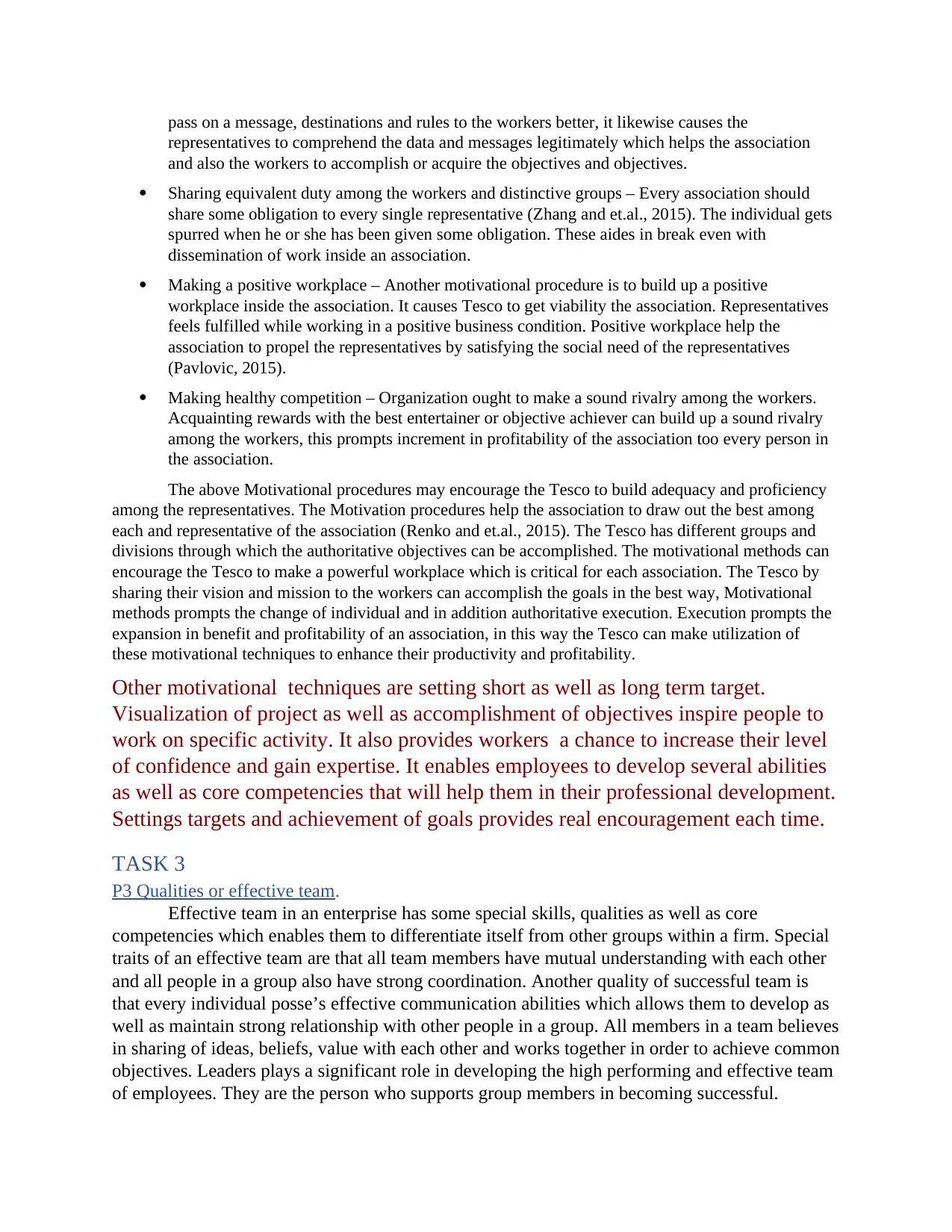
pass on a message, destinations and rules to the workers better, it likewise causes the
representatives to comprehend the data and messages legitimately which helps the association
and also the workers to accomplish or acquire the objectives and objectives.
Sharing equivalent duty among the workers and distinctive groups – Every association should
share some obligation to every single representative (Zhang and et.al., 2015). The individual gets
spurred when he or she has been given some obligation. These aides in break even with
dissemination of work inside an association.
Making a positive workplace – Another motivational procedure is to build up a positive
workplace inside the association. It causes Tesco to get viability the association. Representatives
feels fulfilled while working in a positive business condition. Positive workplace help the
association to propel the representatives by satisfying the social need of the representatives
(Pavlovic, 2015).
Making healthy competition – Organization ought to make a sound rivalry among the workers.
Acquainting rewards with the best entertainer or objective achiever can build up a sound rivalry
among the workers, this prompts increment in profitability of the association too every person in
the association.
The above Motivational procedures may encourage the Tesco to build adequacy and proficiency
among the representatives. The Motivation procedures help the association to draw out the best among
each and representative of the association (Renko and et.al., 2015). The Tesco has different groups and
divisions through which the authoritative objectives can be accomplished. The motivational methods can
encourage the Tesco to make a powerful workplace which is critical for each association. The Tesco by
sharing their vision and mission to the workers can accomplish the goals in the best way, Motivational
methods prompts the change of individual and in addition authoritative execution. Execution prompts the
expansion in benefit and profitability of an association, in this way the Tesco can make utilization of
these motivational techniques to enhance their productivity and profitability.
Other motivational techniques are setting short as well as long term target.
Visualization of project as well as accomplishment of objectives inspire people to
work on specific activity. It also provides workers a chance to increase their level
of confidence and gain expertise. It enables employees to develop several abilities
as well as core competencies that will help them in their professional development.
Settings targets and achievement of goals provides real encouragement each time.
TASK 3
P3 Qualities or effective team.
Effective team in an enterprise has some special skills, qualities as well as core
competencies which enables them to differentiate itself from other groups within a firm. Special
traits of an effective team are that all team members have mutual understanding with each other
and all people in a group also have strong coordination. Another quality of successful team is
that every individual posse’s effective communication abilities which allows them to develop as
well as maintain strong relationship with other people in a group. All members in a team believes
in sharing of ideas, beliefs, value with each other and works together in order to achieve common
objectives. Leaders plays a significant role in developing the high performing and effective team
of employees. They are the person who supports group members in becoming successful.
representatives to comprehend the data and messages legitimately which helps the association
and also the workers to accomplish or acquire the objectives and objectives.
Sharing equivalent duty among the workers and distinctive groups – Every association should
share some obligation to every single representative (Zhang and et.al., 2015). The individual gets
spurred when he or she has been given some obligation. These aides in break even with
dissemination of work inside an association.
Making a positive workplace – Another motivational procedure is to build up a positive
workplace inside the association. It causes Tesco to get viability the association. Representatives
feels fulfilled while working in a positive business condition. Positive workplace help the
association to propel the representatives by satisfying the social need of the representatives
(Pavlovic, 2015).
Making healthy competition – Organization ought to make a sound rivalry among the workers.
Acquainting rewards with the best entertainer or objective achiever can build up a sound rivalry
among the workers, this prompts increment in profitability of the association too every person in
the association.
The above Motivational procedures may encourage the Tesco to build adequacy and proficiency
among the representatives. The Motivation procedures help the association to draw out the best among
each and representative of the association (Renko and et.al., 2015). The Tesco has different groups and
divisions through which the authoritative objectives can be accomplished. The motivational methods can
encourage the Tesco to make a powerful workplace which is critical for each association. The Tesco by
sharing their vision and mission to the workers can accomplish the goals in the best way, Motivational
methods prompts the change of individual and in addition authoritative execution. Execution prompts the
expansion in benefit and profitability of an association, in this way the Tesco can make utilization of
these motivational techniques to enhance their productivity and profitability.
Other motivational techniques are setting short as well as long term target.
Visualization of project as well as accomplishment of objectives inspire people to
work on specific activity. It also provides workers a chance to increase their level
of confidence and gain expertise. It enables employees to develop several abilities
as well as core competencies that will help them in their professional development.
Settings targets and achievement of goals provides real encouragement each time.
TASK 3
P3 Qualities or effective team.
Effective team in an enterprise has some special skills, qualities as well as core
competencies which enables them to differentiate itself from other groups within a firm. Special
traits of an effective team are that all team members have mutual understanding with each other
and all people in a group also have strong coordination. Another quality of successful team is
that every individual posse’s effective communication abilities which allows them to develop as
well as maintain strong relationship with other people in a group. All members in a team believes
in sharing of ideas, beliefs, value with each other and works together in order to achieve common
objectives. Leaders plays a significant role in developing the high performing and effective team
of employees. They are the person who supports group members in becoming successful.
Paraphrase This Document
Need a fresh take? Get an instant paraphrase of this document with our AI Paraphraser
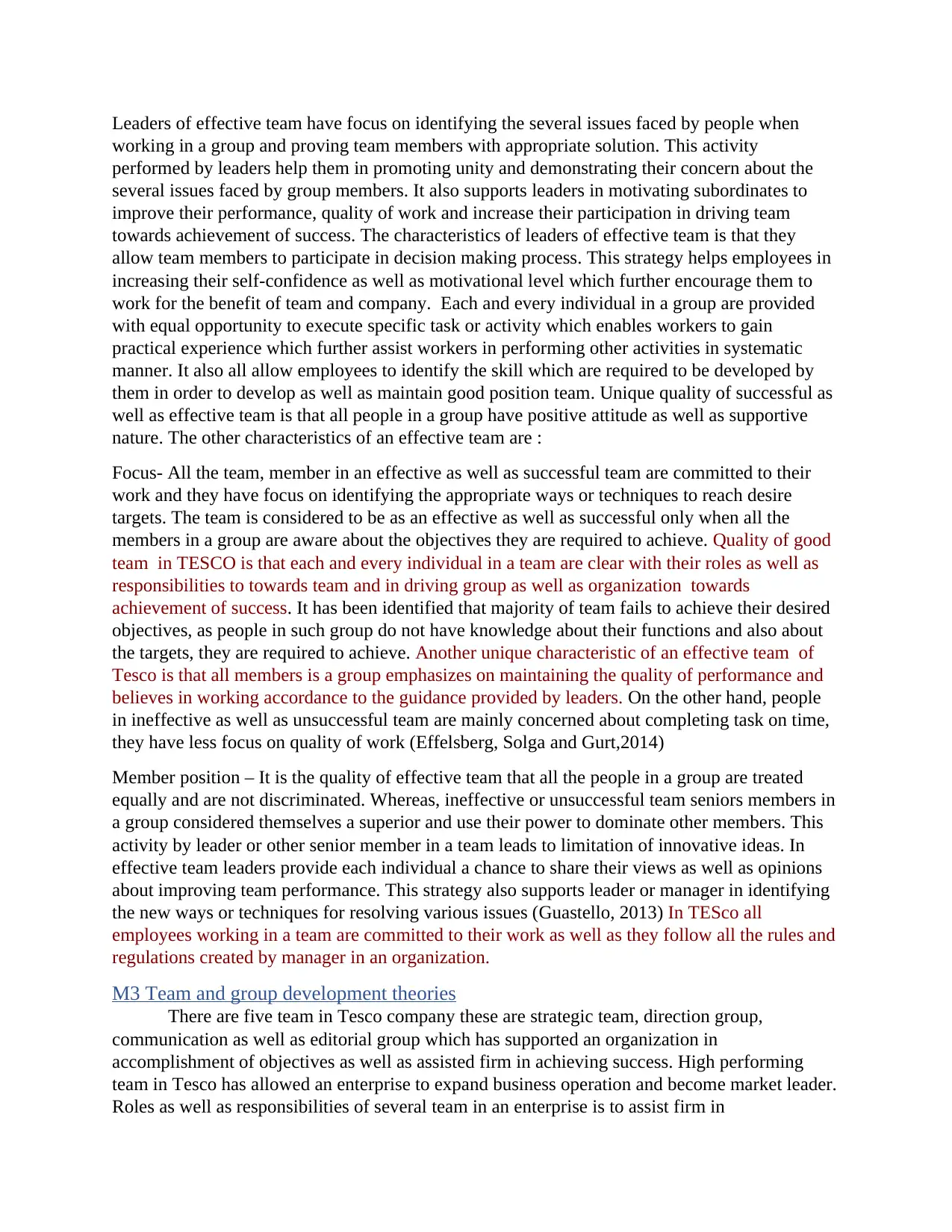
Leaders of effective team have focus on identifying the several issues faced by people when
working in a group and proving team members with appropriate solution. This activity
performed by leaders help them in promoting unity and demonstrating their concern about the
several issues faced by group members. It also supports leaders in motivating subordinates to
improve their performance, quality of work and increase their participation in driving team
towards achievement of success. The characteristics of leaders of effective team is that they
allow team members to participate in decision making process. This strategy helps employees in
increasing their self-confidence as well as motivational level which further encourage them to
work for the benefit of team and company. Each and every individual in a group are provided
with equal opportunity to execute specific task or activity which enables workers to gain
practical experience which further assist workers in performing other activities in systematic
manner. It also all allow employees to identify the skill which are required to be developed by
them in order to develop as well as maintain good position team. Unique quality of successful as
well as effective team is that all people in a group have positive attitude as well as supportive
nature. The other characteristics of an effective team are :
Focus- All the team, member in an effective as well as successful team are committed to their
work and they have focus on identifying the appropriate ways or techniques to reach desire
targets. The team is considered to be as an effective as well as successful only when all the
members in a group are aware about the objectives they are required to achieve. Quality of good
team in TESCO is that each and every individual in a team are clear with their roles as well as
responsibilities to towards team and in driving group as well as organization towards
achievement of success. It has been identified that majority of team fails to achieve their desired
objectives, as people in such group do not have knowledge about their functions and also about
the targets, they are required to achieve. Another unique characteristic of an effective team of
Tesco is that all members is a group emphasizes on maintaining the quality of performance and
believes in working accordance to the guidance provided by leaders. On the other hand, people
in ineffective as well as unsuccessful team are mainly concerned about completing task on time,
they have less focus on quality of work (Effelsberg, Solga and Gurt,2014)
Member position – It is the quality of effective team that all the people in a group are treated
equally and are not discriminated. Whereas, ineffective or unsuccessful team seniors members in
a group considered themselves a superior and use their power to dominate other members. This
activity by leader or other senior member in a team leads to limitation of innovative ideas. In
effective team leaders provide each individual a chance to share their views as well as opinions
about improving team performance. This strategy also supports leader or manager in identifying
the new ways or techniques for resolving various issues (Guastello, 2013) In TESco all
employees working in a team are committed to their work as well as they follow all the rules and
regulations created by manager in an organization.
M3 Team and group development theories
There are five team in Tesco company these are strategic team, direction group,
communication as well as editorial group which has supported an organization in
accomplishment of objectives as well as assisted firm in achieving success. High performing
team in Tesco has allowed an enterprise to expand business operation and become market leader.
Roles as well as responsibilities of several team in an enterprise is to assist firm in
working in a group and proving team members with appropriate solution. This activity
performed by leaders help them in promoting unity and demonstrating their concern about the
several issues faced by group members. It also supports leaders in motivating subordinates to
improve their performance, quality of work and increase their participation in driving team
towards achievement of success. The characteristics of leaders of effective team is that they
allow team members to participate in decision making process. This strategy helps employees in
increasing their self-confidence as well as motivational level which further encourage them to
work for the benefit of team and company. Each and every individual in a group are provided
with equal opportunity to execute specific task or activity which enables workers to gain
practical experience which further assist workers in performing other activities in systematic
manner. It also all allow employees to identify the skill which are required to be developed by
them in order to develop as well as maintain good position team. Unique quality of successful as
well as effective team is that all people in a group have positive attitude as well as supportive
nature. The other characteristics of an effective team are :
Focus- All the team, member in an effective as well as successful team are committed to their
work and they have focus on identifying the appropriate ways or techniques to reach desire
targets. The team is considered to be as an effective as well as successful only when all the
members in a group are aware about the objectives they are required to achieve. Quality of good
team in TESCO is that each and every individual in a team are clear with their roles as well as
responsibilities to towards team and in driving group as well as organization towards
achievement of success. It has been identified that majority of team fails to achieve their desired
objectives, as people in such group do not have knowledge about their functions and also about
the targets, they are required to achieve. Another unique characteristic of an effective team of
Tesco is that all members is a group emphasizes on maintaining the quality of performance and
believes in working accordance to the guidance provided by leaders. On the other hand, people
in ineffective as well as unsuccessful team are mainly concerned about completing task on time,
they have less focus on quality of work (Effelsberg, Solga and Gurt,2014)
Member position – It is the quality of effective team that all the people in a group are treated
equally and are not discriminated. Whereas, ineffective or unsuccessful team seniors members in
a group considered themselves a superior and use their power to dominate other members. This
activity by leader or other senior member in a team leads to limitation of innovative ideas. In
effective team leaders provide each individual a chance to share their views as well as opinions
about improving team performance. This strategy also supports leader or manager in identifying
the new ways or techniques for resolving various issues (Guastello, 2013) In TESco all
employees working in a team are committed to their work as well as they follow all the rules and
regulations created by manager in an organization.
M3 Team and group development theories
There are five team in Tesco company these are strategic team, direction group,
communication as well as editorial group which has supported an organization in
accomplishment of objectives as well as assisted firm in achieving success. High performing
team in Tesco has allowed an enterprise to expand business operation and become market leader.
Roles as well as responsibilities of several team in an enterprise is to assist firm in
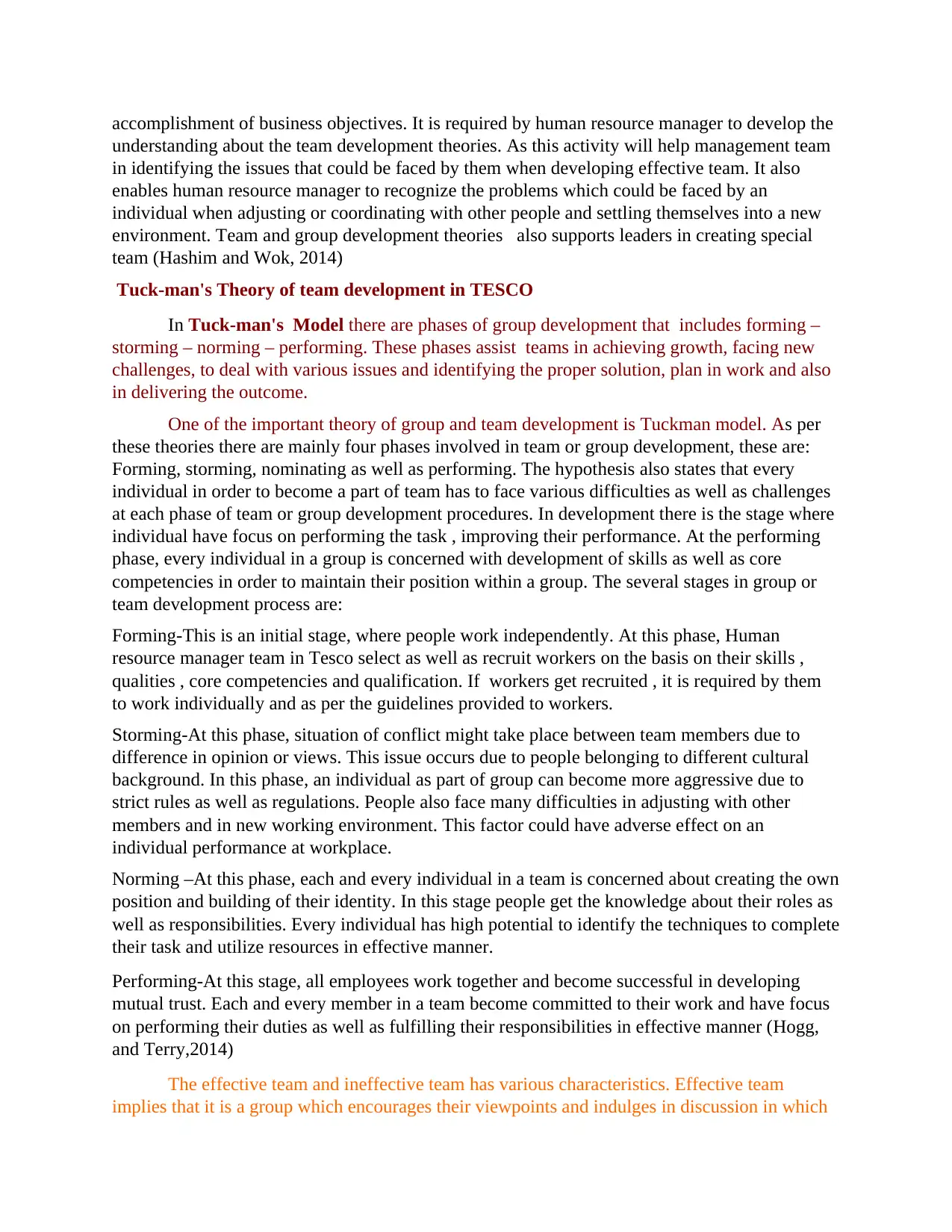
accomplishment of business objectives. It is required by human resource manager to develop the
understanding about the team development theories. As this activity will help management team
in identifying the issues that could be faced by them when developing effective team. It also
enables human resource manager to recognize the problems which could be faced by an
individual when adjusting or coordinating with other people and settling themselves into a new
environment. Team and group development theories also supports leaders in creating special
team (Hashim and Wok, 2014)
Tuck-man's Theory of team development in TESCO
In Tuck-man's Model there are phases of group development that includes forming –
storming – norming – performing. These phases assist teams in achieving growth, facing new
challenges, to deal with various issues and identifying the proper solution, plan in work and also
in delivering the outcome.
One of the important theory of group and team development is Tuckman model. As per
these theories there are mainly four phases involved in team or group development, these are:
Forming, storming, nominating as well as performing. The hypothesis also states that every
individual in order to become a part of team has to face various difficulties as well as challenges
at each phase of team or group development procedures. In development there is the stage where
individual have focus on performing the task , improving their performance. At the performing
phase, every individual in a group is concerned with development of skills as well as core
competencies in order to maintain their position within a group. The several stages in group or
team development process are:
Forming-This is an initial stage, where people work independently. At this phase, Human
resource manager team in Tesco select as well as recruit workers on the basis on their skills ,
qualities , core competencies and qualification. If workers get recruited , it is required by them
to work individually and as per the guidelines provided to workers.
Storming-At this phase, situation of conflict might take place between team members due to
difference in opinion or views. This issue occurs due to people belonging to different cultural
background. In this phase, an individual as part of group can become more aggressive due to
strict rules as well as regulations. People also face many difficulties in adjusting with other
members and in new working environment. This factor could have adverse effect on an
individual performance at workplace.
Norming –At this phase, each and every individual in a team is concerned about creating the own
position and building of their identity. In this stage people get the knowledge about their roles as
well as responsibilities. Every individual has high potential to identify the techniques to complete
their task and utilize resources in effective manner.
Performing-At this stage, all employees work together and become successful in developing
mutual trust. Each and every member in a team become committed to their work and have focus
on performing their duties as well as fulfilling their responsibilities in effective manner (Hogg,
and Terry,2014)
The effective team and ineffective team has various characteristics. Effective team
implies that it is a group which encourages their viewpoints and indulges in discussion in which
understanding about the team development theories. As this activity will help management team
in identifying the issues that could be faced by them when developing effective team. It also
enables human resource manager to recognize the problems which could be faced by an
individual when adjusting or coordinating with other people and settling themselves into a new
environment. Team and group development theories also supports leaders in creating special
team (Hashim and Wok, 2014)
Tuck-man's Theory of team development in TESCO
In Tuck-man's Model there are phases of group development that includes forming –
storming – norming – performing. These phases assist teams in achieving growth, facing new
challenges, to deal with various issues and identifying the proper solution, plan in work and also
in delivering the outcome.
One of the important theory of group and team development is Tuckman model. As per
these theories there are mainly four phases involved in team or group development, these are:
Forming, storming, nominating as well as performing. The hypothesis also states that every
individual in order to become a part of team has to face various difficulties as well as challenges
at each phase of team or group development procedures. In development there is the stage where
individual have focus on performing the task , improving their performance. At the performing
phase, every individual in a group is concerned with development of skills as well as core
competencies in order to maintain their position within a group. The several stages in group or
team development process are:
Forming-This is an initial stage, where people work independently. At this phase, Human
resource manager team in Tesco select as well as recruit workers on the basis on their skills ,
qualities , core competencies and qualification. If workers get recruited , it is required by them
to work individually and as per the guidelines provided to workers.
Storming-At this phase, situation of conflict might take place between team members due to
difference in opinion or views. This issue occurs due to people belonging to different cultural
background. In this phase, an individual as part of group can become more aggressive due to
strict rules as well as regulations. People also face many difficulties in adjusting with other
members and in new working environment. This factor could have adverse effect on an
individual performance at workplace.
Norming –At this phase, each and every individual in a team is concerned about creating the own
position and building of their identity. In this stage people get the knowledge about their roles as
well as responsibilities. Every individual has high potential to identify the techniques to complete
their task and utilize resources in effective manner.
Performing-At this stage, all employees work together and become successful in developing
mutual trust. Each and every member in a team become committed to their work and have focus
on performing their duties as well as fulfilling their responsibilities in effective manner (Hogg,
and Terry,2014)
The effective team and ineffective team has various characteristics. Effective team
implies that it is a group which encourages their viewpoints and indulges in discussion in which
⊘ This is a preview!⊘
Do you want full access?
Subscribe today to unlock all pages.

Trusted by 1+ million students worldwide
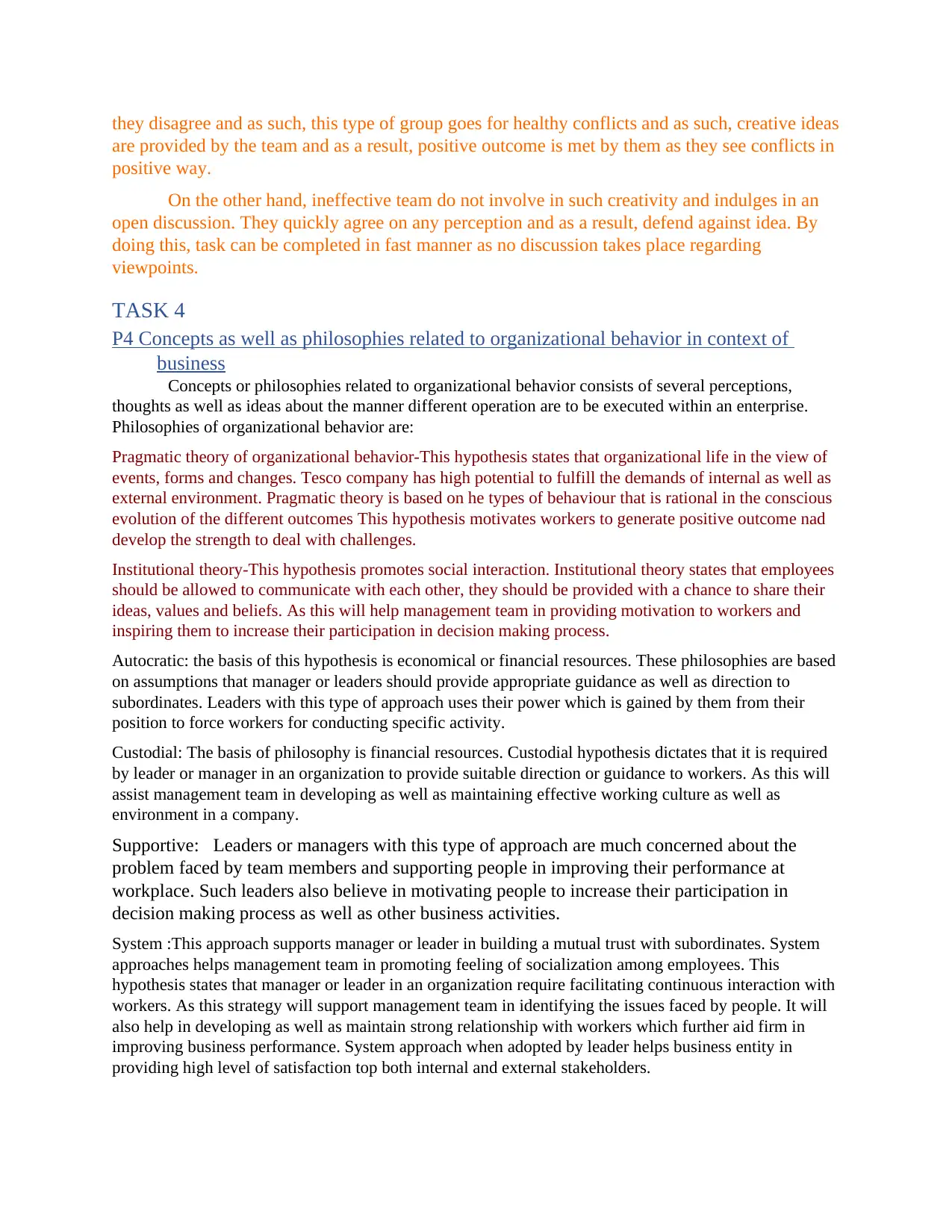
they disagree and as such, this type of group goes for healthy conflicts and as such, creative ideas
are provided by the team and as a result, positive outcome is met by them as they see conflicts in
positive way.
On the other hand, ineffective team do not involve in such creativity and indulges in an
open discussion. They quickly agree on any perception and as a result, defend against idea. By
doing this, task can be completed in fast manner as no discussion takes place regarding
viewpoints.
TASK 4
P4 Concepts as well as philosophies related to organizational behavior in context of
business
Concepts or philosophies related to organizational behavior consists of several perceptions,
thoughts as well as ideas about the manner different operation are to be executed within an enterprise.
Philosophies of organizational behavior are:
Pragmatic theory of organizational behavior-This hypothesis states that organizational life in the view of
events, forms and changes. Tesco company has high potential to fulfill the demands of internal as well as
external environment. Pragmatic theory is based on he types of behaviour that is rational in the conscious
evolution of the different outcomes This hypothesis motivates workers to generate positive outcome nad
develop the strength to deal with challenges.
Institutional theory-This hypothesis promotes social interaction. Institutional theory states that employees
should be allowed to communicate with each other, they should be provided with a chance to share their
ideas, values and beliefs. As this will help management team in providing motivation to workers and
inspiring them to increase their participation in decision making process.
Autocratic: the basis of this hypothesis is economical or financial resources. These philosophies are based
on assumptions that manager or leaders should provide appropriate guidance as well as direction to
subordinates. Leaders with this type of approach uses their power which is gained by them from their
position to force workers for conducting specific activity.
Custodial: The basis of philosophy is financial resources. Custodial hypothesis dictates that it is required
by leader or manager in an organization to provide suitable direction or guidance to workers. As this will
assist management team in developing as well as maintaining effective working culture as well as
environment in a company.
Supportive: Leaders or managers with this type of approach are much concerned about the
problem faced by team members and supporting people in improving their performance at
workplace. Such leaders also believe in motivating people to increase their participation in
decision making process as well as other business activities.
System :This approach supports manager or leader in building a mutual trust with subordinates. System
approaches helps management team in promoting feeling of socialization among employees. This
hypothesis states that manager or leader in an organization require facilitating continuous interaction with
workers. As this strategy will support management team in identifying the issues faced by people. It will
also help in developing as well as maintain strong relationship with workers which further aid firm in
improving business performance. System approach when adopted by leader helps business entity in
providing high level of satisfaction top both internal and external stakeholders.
are provided by the team and as a result, positive outcome is met by them as they see conflicts in
positive way.
On the other hand, ineffective team do not involve in such creativity and indulges in an
open discussion. They quickly agree on any perception and as a result, defend against idea. By
doing this, task can be completed in fast manner as no discussion takes place regarding
viewpoints.
TASK 4
P4 Concepts as well as philosophies related to organizational behavior in context of
business
Concepts or philosophies related to organizational behavior consists of several perceptions,
thoughts as well as ideas about the manner different operation are to be executed within an enterprise.
Philosophies of organizational behavior are:
Pragmatic theory of organizational behavior-This hypothesis states that organizational life in the view of
events, forms and changes. Tesco company has high potential to fulfill the demands of internal as well as
external environment. Pragmatic theory is based on he types of behaviour that is rational in the conscious
evolution of the different outcomes This hypothesis motivates workers to generate positive outcome nad
develop the strength to deal with challenges.
Institutional theory-This hypothesis promotes social interaction. Institutional theory states that employees
should be allowed to communicate with each other, they should be provided with a chance to share their
ideas, values and beliefs. As this will help management team in providing motivation to workers and
inspiring them to increase their participation in decision making process.
Autocratic: the basis of this hypothesis is economical or financial resources. These philosophies are based
on assumptions that manager or leaders should provide appropriate guidance as well as direction to
subordinates. Leaders with this type of approach uses their power which is gained by them from their
position to force workers for conducting specific activity.
Custodial: The basis of philosophy is financial resources. Custodial hypothesis dictates that it is required
by leader or manager in an organization to provide suitable direction or guidance to workers. As this will
assist management team in developing as well as maintaining effective working culture as well as
environment in a company.
Supportive: Leaders or managers with this type of approach are much concerned about the
problem faced by team members and supporting people in improving their performance at
workplace. Such leaders also believe in motivating people to increase their participation in
decision making process as well as other business activities.
System :This approach supports manager or leader in building a mutual trust with subordinates. System
approaches helps management team in promoting feeling of socialization among employees. This
hypothesis states that manager or leader in an organization require facilitating continuous interaction with
workers. As this strategy will support management team in identifying the issues faced by people. It will
also help in developing as well as maintain strong relationship with workers which further aid firm in
improving business performance. System approach when adopted by leader helps business entity in
providing high level of satisfaction top both internal and external stakeholders.
Paraphrase This Document
Need a fresh take? Get an instant paraphrase of this document with our AI Paraphraser
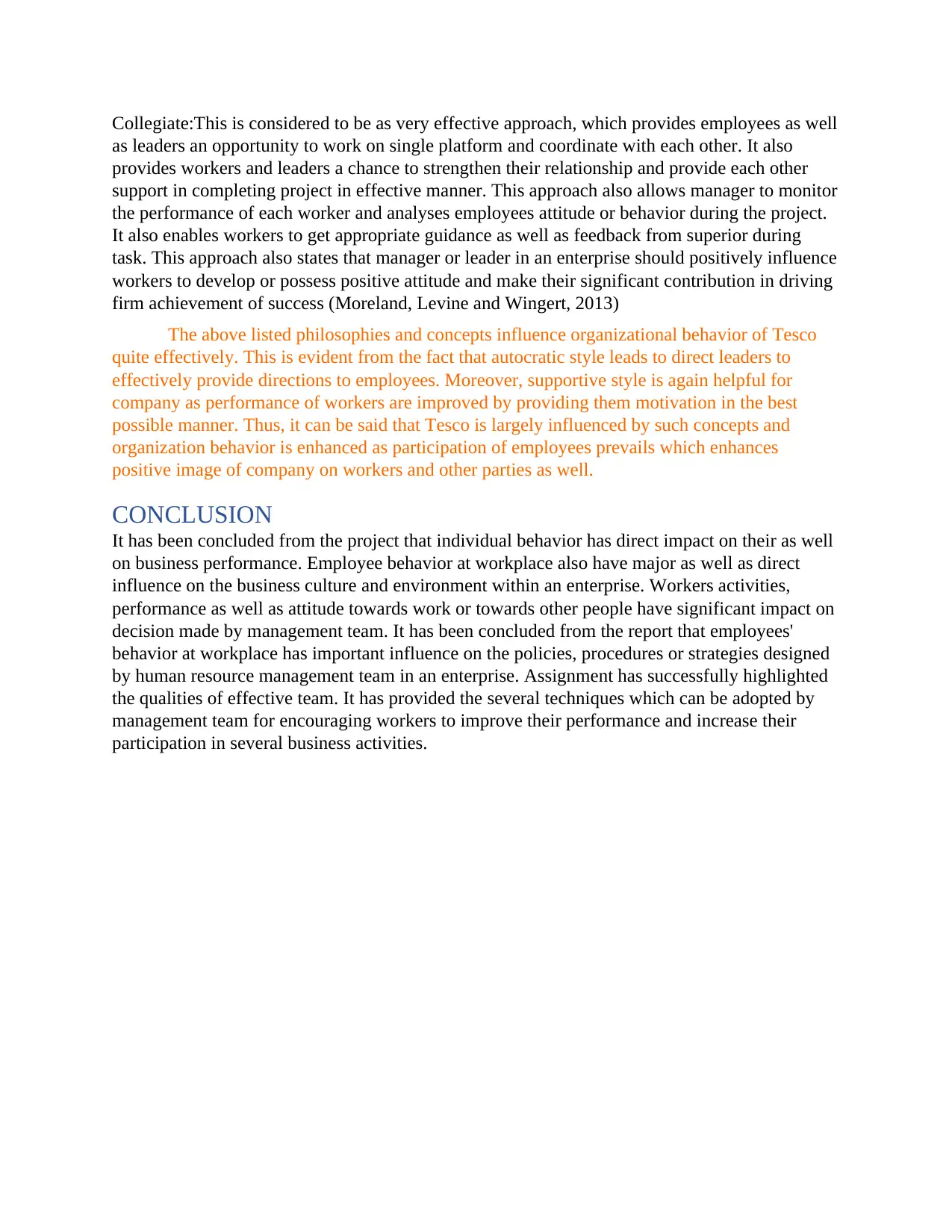
Collegiate:This is considered to be as very effective approach, which provides employees as well
as leaders an opportunity to work on single platform and coordinate with each other. It also
provides workers and leaders a chance to strengthen their relationship and provide each other
support in completing project in effective manner. This approach also allows manager to monitor
the performance of each worker and analyses employees attitude or behavior during the project.
It also enables workers to get appropriate guidance as well as feedback from superior during
task. This approach also states that manager or leader in an enterprise should positively influence
workers to develop or possess positive attitude and make their significant contribution in driving
firm achievement of success (Moreland, Levine and Wingert, 2013)
The above listed philosophies and concepts influence organizational behavior of Tesco
quite effectively. This is evident from the fact that autocratic style leads to direct leaders to
effectively provide directions to employees. Moreover, supportive style is again helpful for
company as performance of workers are improved by providing them motivation in the best
possible manner. Thus, it can be said that Tesco is largely influenced by such concepts and
organization behavior is enhanced as participation of employees prevails which enhances
positive image of company on workers and other parties as well.
CONCLUSION
It has been concluded from the project that individual behavior has direct impact on their as well
on business performance. Employee behavior at workplace also have major as well as direct
influence on the business culture and environment within an enterprise. Workers activities,
performance as well as attitude towards work or towards other people have significant impact on
decision made by management team. It has been concluded from the report that employees'
behavior at workplace has important influence on the policies, procedures or strategies designed
by human resource management team in an enterprise. Assignment has successfully highlighted
the qualities of effective team. It has provided the several techniques which can be adopted by
management team for encouraging workers to improve their performance and increase their
participation in several business activities.
as leaders an opportunity to work on single platform and coordinate with each other. It also
provides workers and leaders a chance to strengthen their relationship and provide each other
support in completing project in effective manner. This approach also allows manager to monitor
the performance of each worker and analyses employees attitude or behavior during the project.
It also enables workers to get appropriate guidance as well as feedback from superior during
task. This approach also states that manager or leader in an enterprise should positively influence
workers to develop or possess positive attitude and make their significant contribution in driving
firm achievement of success (Moreland, Levine and Wingert, 2013)
The above listed philosophies and concepts influence organizational behavior of Tesco
quite effectively. This is evident from the fact that autocratic style leads to direct leaders to
effectively provide directions to employees. Moreover, supportive style is again helpful for
company as performance of workers are improved by providing them motivation in the best
possible manner. Thus, it can be said that Tesco is largely influenced by such concepts and
organization behavior is enhanced as participation of employees prevails which enhances
positive image of company on workers and other parties as well.
CONCLUSION
It has been concluded from the project that individual behavior has direct impact on their as well
on business performance. Employee behavior at workplace also have major as well as direct
influence on the business culture and environment within an enterprise. Workers activities,
performance as well as attitude towards work or towards other people have significant impact on
decision made by management team. It has been concluded from the report that employees'
behavior at workplace has important influence on the policies, procedures or strategies designed
by human resource management team in an enterprise. Assignment has successfully highlighted
the qualities of effective team. It has provided the several techniques which can be adopted by
management team for encouraging workers to improve their performance and increase their
participation in several business activities.
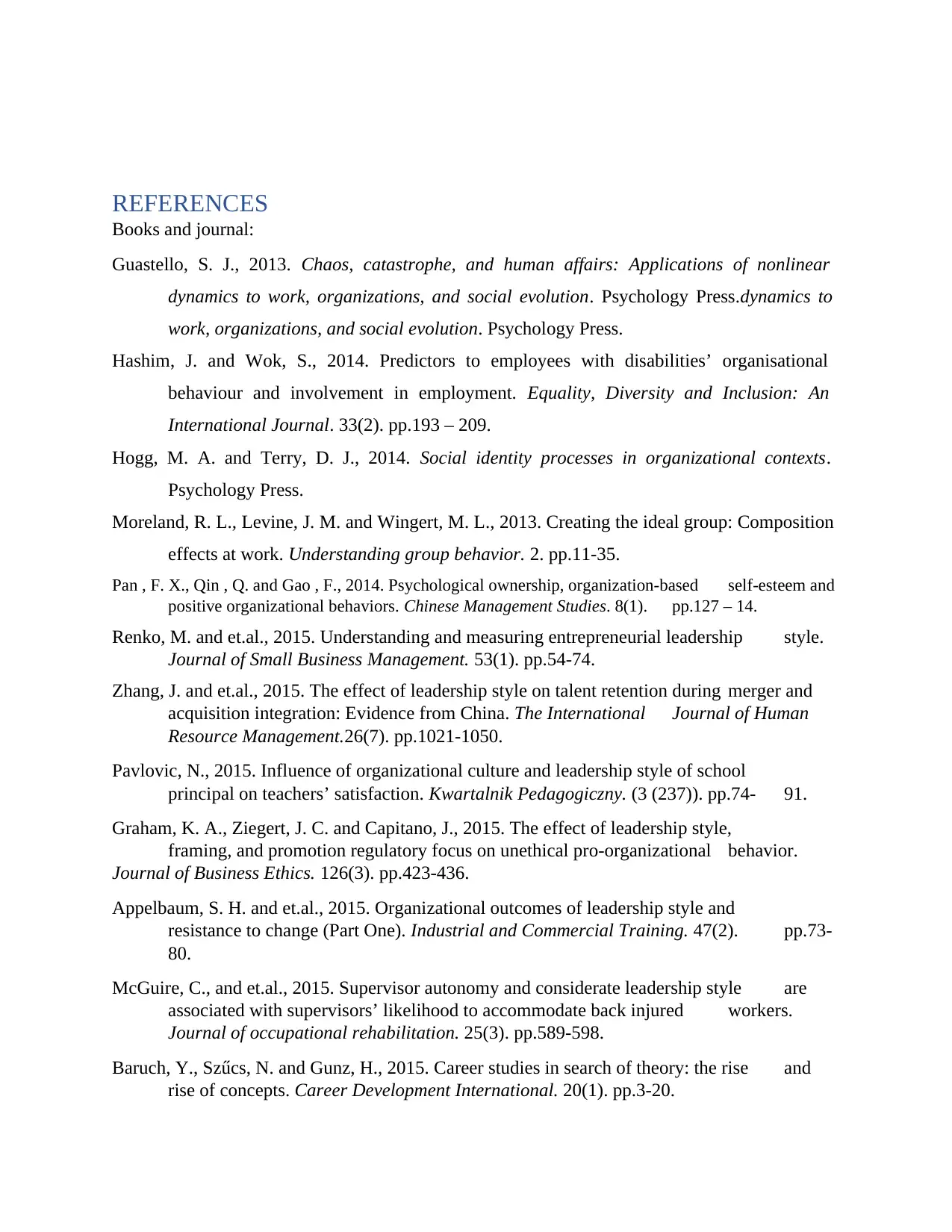
REFERENCES
Books and journal:
Guastello, S. J., 2013. Chaos, catastrophe, and human affairs: Applications of nonlinear
dynamics to work, organizations, and social evolution. Psychology Press.dynamics to
work, organizations, and social evolution. Psychology Press.
Hashim, J. and Wok, S., 2014. Predictors to employees with disabilities’ organisational
behaviour and involvement in employment. Equality, Diversity and Inclusion: An
International Journal. 33(2). pp.193 – 209.
Hogg, M. A. and Terry, D. J., 2014. Social identity processes in organizational contexts.
Psychology Press.
Moreland, R. L., Levine, J. M. and Wingert, M. L., 2013. Creating the ideal group: Composition
effects at work. Understanding group behavior. 2. pp.11-35.
Pan , F. X., Qin , Q. and Gao , F., 2014. Psychological ownership, organization-based self-esteem and
positive organizational behaviors. Chinese Management Studies. 8(1). pp.127 – 14.
Renko, M. and et.al., 2015. Understanding and measuring entrepreneurial leadership style.
Journal of Small Business Management. 53(1). pp.54-74.
Zhang, J. and et.al., 2015. The effect of leadership style on talent retention during merger and
acquisition integration: Evidence from China. The International Journal of Human
Resource Management.26(7). pp.1021-1050.
Pavlovic, N., 2015. Influence of organizational culture and leadership style of school
principal on teachers’ satisfaction. Kwartalnik Pedagogiczny. (3 (237)). pp.74- 91.
Graham, K. A., Ziegert, J. C. and Capitano, J., 2015. The effect of leadership style,
framing, and promotion regulatory focus on unethical pro-organizational behavior.
Journal of Business Ethics. 126(3). pp.423-436.
Appelbaum, S. H. and et.al., 2015. Organizational outcomes of leadership style and
resistance to change (Part One). Industrial and Commercial Training. 47(2). pp.73-
80.
McGuire, C., and et.al., 2015. Supervisor autonomy and considerate leadership style are
associated with supervisors’ likelihood to accommodate back injured workers.
Journal of occupational rehabilitation. 25(3). pp.589-598.
Baruch, Y., Szűcs, N. and Gunz, H., 2015. Career studies in search of theory: the rise and
rise of concepts. Career Development International. 20(1). pp.3-20.
Books and journal:
Guastello, S. J., 2013. Chaos, catastrophe, and human affairs: Applications of nonlinear
dynamics to work, organizations, and social evolution. Psychology Press.dynamics to
work, organizations, and social evolution. Psychology Press.
Hashim, J. and Wok, S., 2014. Predictors to employees with disabilities’ organisational
behaviour and involvement in employment. Equality, Diversity and Inclusion: An
International Journal. 33(2). pp.193 – 209.
Hogg, M. A. and Terry, D. J., 2014. Social identity processes in organizational contexts.
Psychology Press.
Moreland, R. L., Levine, J. M. and Wingert, M. L., 2013. Creating the ideal group: Composition
effects at work. Understanding group behavior. 2. pp.11-35.
Pan , F. X., Qin , Q. and Gao , F., 2014. Psychological ownership, organization-based self-esteem and
positive organizational behaviors. Chinese Management Studies. 8(1). pp.127 – 14.
Renko, M. and et.al., 2015. Understanding and measuring entrepreneurial leadership style.
Journal of Small Business Management. 53(1). pp.54-74.
Zhang, J. and et.al., 2015. The effect of leadership style on talent retention during merger and
acquisition integration: Evidence from China. The International Journal of Human
Resource Management.26(7). pp.1021-1050.
Pavlovic, N., 2015. Influence of organizational culture and leadership style of school
principal on teachers’ satisfaction. Kwartalnik Pedagogiczny. (3 (237)). pp.74- 91.
Graham, K. A., Ziegert, J. C. and Capitano, J., 2015. The effect of leadership style,
framing, and promotion regulatory focus on unethical pro-organizational behavior.
Journal of Business Ethics. 126(3). pp.423-436.
Appelbaum, S. H. and et.al., 2015. Organizational outcomes of leadership style and
resistance to change (Part One). Industrial and Commercial Training. 47(2). pp.73-
80.
McGuire, C., and et.al., 2015. Supervisor autonomy and considerate leadership style are
associated with supervisors’ likelihood to accommodate back injured workers.
Journal of occupational rehabilitation. 25(3). pp.589-598.
Baruch, Y., Szűcs, N. and Gunz, H., 2015. Career studies in search of theory: the rise and
rise of concepts. Career Development International. 20(1). pp.3-20.
⊘ This is a preview!⊘
Do you want full access?
Subscribe today to unlock all pages.

Trusted by 1+ million students worldwide
1 out of 13
Related Documents
Your All-in-One AI-Powered Toolkit for Academic Success.
+13062052269
info@desklib.com
Available 24*7 on WhatsApp / Email
![[object Object]](/_next/static/media/star-bottom.7253800d.svg)
Unlock your academic potential
Copyright © 2020–2025 A2Z Services. All Rights Reserved. Developed and managed by ZUCOL.




